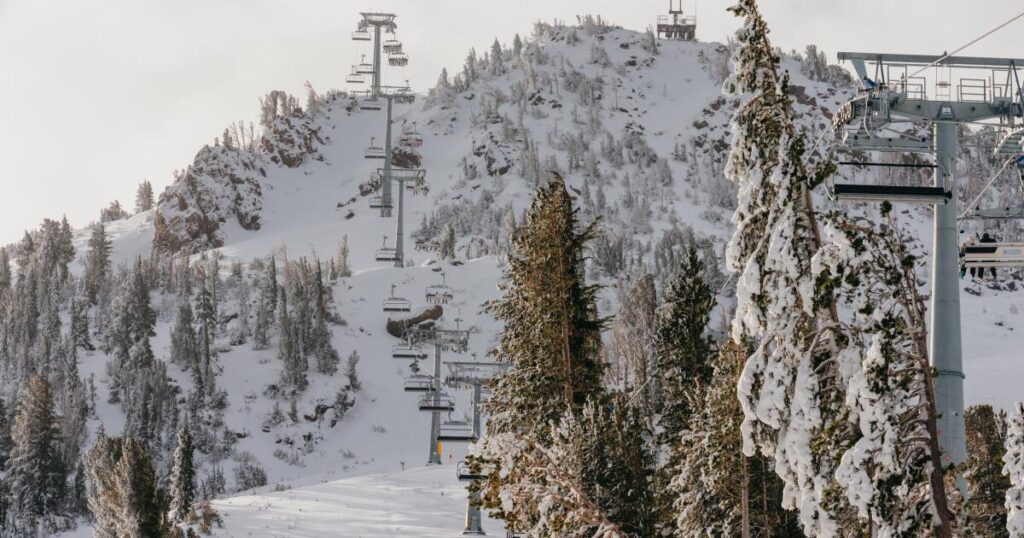A string of early season storms that drenched Californians last week lifted much of the state out of drought and significantly reduced the risk of wildfires, experts say.
It’s been the wettest November on record for Southland cities such as Van Nuys and San Luis Obispo. Santa Barbara has received an eye-popping 9.5 inches of rain since Oct. 1, marking the city’s wettest start to the water year on record.
And overall the state is sitting at 186% of its average rain so far this water year, according to the Department of Water Resources.
But experts say that despite the auspicious start, it’s still too soon to say how the rest of California’s traditional rainy season will shape up.
“The overall impact on our water supply is TBD [to be determined] is the best way to put it,” said Jeff Mount, senior fellow at the Public Policy Institute of California’s Water Policy Center. “We haven’t even really gotten into the wet season yet.”
California receives the vast bulk of its rain and snow between December and March, trapping the runoff in its reservoirs to mete out during the hot, dry seasons that follow.
Those major reservoirs are now filled to 100% to 145% of average for this date. That’s not just from the recent storms — early season rains tend to soak mostly into the parched ground — but also because California is building on three prior wet winters, state climatologist Michael Anderson said.
A record-breaking wet 2022-23 winter ended the state’s driest three-year period on record. That was followed by two years that were wetter than average for Northern California but drier than average for the southern half, amounting to roughly average precipitation statewide.
According to the latest U.S. Drought Monitor report, issued last week before the last of the recent storms had fully soaked the state, more than 70% of California was drought-free, compared with 49% a week before. Nearly 47% of Los Angeles County emerged from moderate drought, with the other portions improving to abnormally dry, the map shows. Abnormally dry conditions also ended in Ventura, Santa Barbara, San Luis Obispo and much of Kern counties, along with portions of Central California, according to the map. In the far southern and southeastern reaches of the state, conditions improved but still range from abnormally dry to moderate drought, the map shows.
The early season storms will play an important role in priming watersheds for the rest of the winter, experts said. By soaking soils, they’ll enable future rainstorms to more easily run off into reservoirs and snow to accumulate in the Sierra Nevada.
“Building the snowpack on hydrated watersheds will help us avoid losing potential spring runoff to dry soils later in the season,” Anderson wrote in an email.
Snowpack is crucial to sustaining California through its hot, dry seasons because it runs down into waterways as it melts, topping off the reservoirs and providing at least 30% of the state’s water supply, said Andrew Schwartz, director of UC Berkeley’s Central Sierra Snow Lab.
The research station at Donner Pass has recorded 22 inches of snow. Although that’s about 89% of normal for this date, warmer temperatures mean that much of it has already melted, Schwartz said. The snow water equivalent, which measures how much water the snow would produce if it were to melt, now stands at 50%, he said.
“That’s really something that tells the tale, so far, of this season,” he said. “We’ve had plenty of rain across the Sierra, but not as much snowfall as we would ordinarily hope for up to this point.”
This dynamic has become increasingly common with climate change, Schwartz said. Snow is often developing later in the season and melting earlier, and more precipitation is falling as rain, he said. Because reservoirs need to leave some room in the winter for flood mitigation, they aren’t always able to capture all this ill-timed runoff, he said.
And the earlier the snow melts, the more time plants and soils have to dry out in the summer heat, priming the landscape for large wildfires, Schwartz said. Although Northern California has been spared massive fires for the last few seasons, Schwartz fears that luck could run out if the region doesn’t receive at least an average amount snow this year.
For now, long-range forecasts are calling for equal chances of wet and dry conditions this winter, Mount said. What happens in the next few months will be key. California depends on just a few strong atmospheric river storms to provide moisture; as little as five to seven can end up being responsible for more than half of the year’s water supply, he said.
“We’re living on the edge all the time,” he said. “A handful of storms make up the difference of whether we have a dry year or a wet year.”
Although the state’s drought picture has improved for the moment, scientists caution that conditions across the West are trending hotter and drier because of the burning of fossil fuels and resultant climate change. In addition to importing water from Northern California via the Sacramento-San Joaquin River Delta, Southern California relies on water from the Colorado River. That waterway continues to be in shortage, with its largest reservoir only about one-third full.
What’s more, research has shown that as the planet has warmed, the atmosphere has become thirstier, sucking more moisture from plants and soils and ensuring that dry years are drier. At the same time, there’s healthy debate over whether the same phenomenon is also making wet periods wetter, as warmer air can hold more moisture, potentially supercharging storms.
As a result, swings between wet and dry on a year-to-year basis — and even within a year — seem to be getting bigger in California and elsewhere, Mount said. That increase in uncertainty has made managing water supplies more difficult overall, he said.
Still, because of its climate, California has plenty of experience dealing with such extremes, said Jay Lund, professor emeritus of civil and environmental engineering at UC Davis.
“We always have to be preparing for floods and preparing for drought, no matter how wet or dry it is.”
Staff writer Ian James contributed to this report.
The post Drought killer: California storms fill reservoirs, build up Sierra snowpack appeared first on Los Angeles Times.




